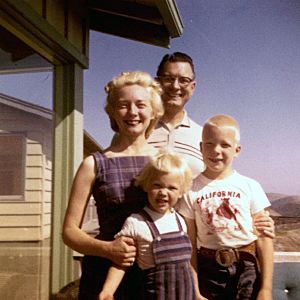Nuclear family facts for kids
A nuclear family is a common type of family. It usually includes a mother, a father, and their children. This family unit lives together in one home.
Sometimes, people have different ideas about what a nuclear family includes. Some think it only means biological children. Others believe it can also include stepchildren or adopted children. A nuclear family is often part of a larger extended family, which includes grandparents, aunts, uncles, and cousins.
Contents
Understanding the Nuclear Family
A nuclear family is often seen as the basic building block of society. It focuses on the direct relationships between parents and their children. This type of family structure has been common in many cultures around the world.
What Makes a Nuclear Family?
The main parts of a nuclear family are:
- Parents: Usually a mother and a father.
- Children: Their sons and daughters.
These family members live together and share responsibilities. They support each other emotionally and financially. This close-knit group helps children grow and learn.
History of the Nuclear Family
The idea of the "nuclear family" might seem modern, but this family structure has existed for a very long time. The term itself is quite new, but the way people lived is not.
When the Term Was First Used
The phrase nuclear family was first used in 1947. This was after World War II. It became popular to describe the typical family unit in many Western countries.
Ancient Family Structures
Even though the term is new, people have lived in nuclear families for thousands of years. In 2005, archaeologists made an exciting discovery. They found 4,600-year-old graves in Germany. These graves held adults and children who were related. Researchers believe this shows that nuclear families were common even in ancient times.
Changes Over Time
During the medieval period in Europe, large family groups were more common. These groups included many relatives living close together, like clans. However, by the late medieval period, the nuclear family began to become more widespread. This shift happened as societies changed and people moved to new places.
See also
 In Spanish: Familia nuclear para niños
In Spanish: Familia nuclear para niños


